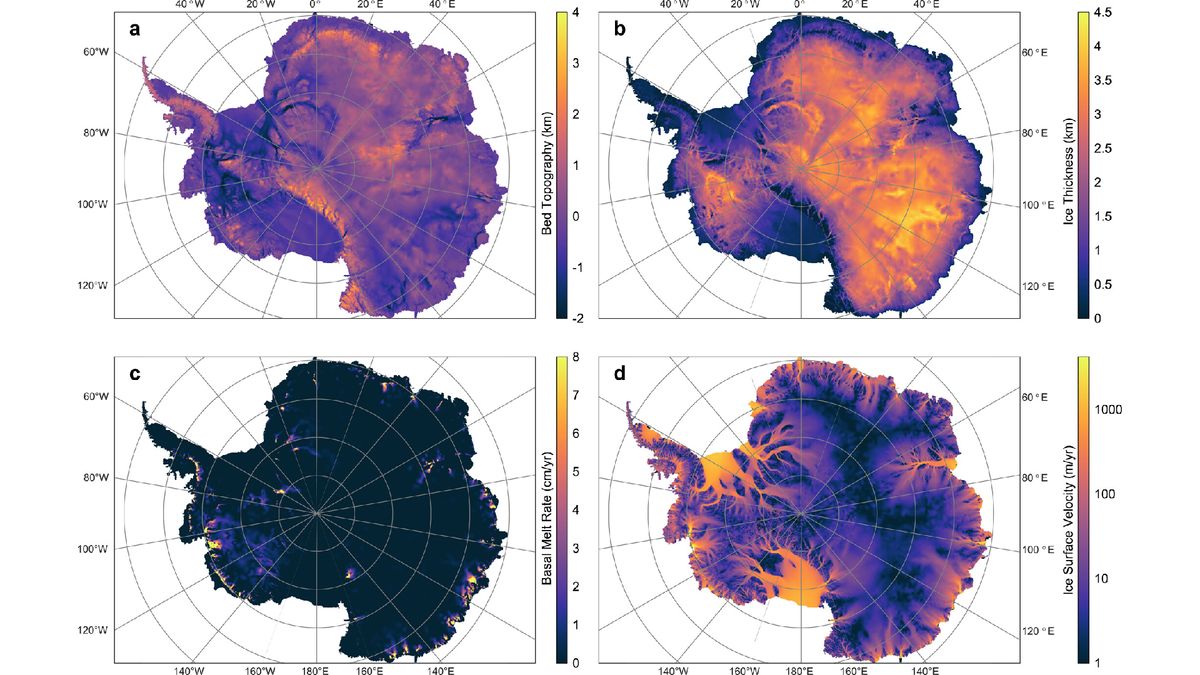An extensive model of the Antarctic ice sheet is helping researchers peer deep beneath the ice to reveal the continent’s hidden plumbing.
Scientists used computer models to predict how water flows under the entire Antarctic ice sheet, which dictates where and how quickly glaciers move toward the ocean. The findings, published Dec. 29, 2024 in the journal Geophysical Research Letters, will improve predictions of ice sheet stability and future sea level rise.
Current models predict that ice melt from Antarctica could raise sea levels up to 12 inches (30 centimeters) by 2100. Some of this melt comes from ice sliding from the continent’s bedrock into the ocean. Liquid water beneath the ice sheet can lubricate the ice, similar to sliding a glass across a wet countertop.
But the extent of this lubrication isn’t uniform across the ice sheet — it depends on the weight of the ice and the depth and pressure of the water beneath it. Understanding how these factors vary is important for accurately predicting how much ice will flow into the ocean, and how quickly it will move. While models of smaller individual areas account for the effects of water at the base of the ice sheet, the new study is the first to incorporate it for the whole continent.
Related: Never-before-seen shapes up to 1,300 feet long discovered beneath Antarctic ice
To simulate how subglacial water affects glacier motion, the researchers combined two existing models: the Glacier Drainage System Model, which simulates the way water flows under ice sheets; and the Ice-sheet and Sea-level System Model, which predicts how the ice sheet will flow and change in response to various factors, such as temperature.
The combined model “allows us to identify where water is underneath the ice, or model where the water would be underneath the ice, where it’s particularly thick and the pressures are high enough to enable the ice to slide and to flow faster,” Neil Ross, a geophysicist at Newcastle University in the U.K. who was not involved in the new study, told Live Science.
The researchers modeled the effective pressure at the base of the ice — the difference between the weight of the ice and the water pressure beneath it. “As that approaches zero, we’re approaching the situation where the ice is basically free, floating on the base of water,” Rupert Gladstone, a computational glaciologist at the University of Lapland in Finland who was not involved in the research, told Live Science.
The model revealed that the lowest effective pressures are in the interior of the continent and beneath outlet glaciers along the edge of the ice sheet, meaning the ice flows fastest in these regions. Meanwhile, floating ice shelves around the edge of the continent slow ice flow into the ocean. If these ice shelves melt, more ice could flow from the bedrock into the ocean and contribute to sea level rise, the authors wrote.
The model also accurately predicted the locations of known subglacial lakes in western Antarctica. In addition, it predicted the locations of large channels beneath the ice where subglacial water flows into the ocean. Many of these locations align with areas of the ice shelf that are known to melt quickly, suggesting that fresh water entering the ocean from these channels impacts melt rates.
Further studies in Antarctica could look for these features in areas predicted by the model. “It’s enabled us to identify where future field observations might be required,” Ross said. Field studies could help refine the model and help scientists better understand how subglacial water affects ice flow, Ross added.
Test your knowledge of Antarctica


